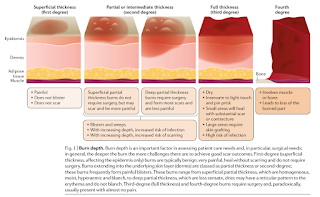Burns
Introduction
Burns are characterized as
- First degree - Red/painful, minor swelling.
- Second degree - Thicker, very painful, produce blisters.
- Third degree - Damage to all layers of skin, appears white or charred.
The Need of Referral
Burns from chemical or electricity exposure or in immunosuppressed patients should be referred for emergency medical care.
If the burn is first or second degree, OTC treatment is acceptable if the area is less than two inches in diameter and not located on the face, over a major joint or on the feet.
- In diabetes, a burn on a foot, even mild, could lead to an amputation. Vigilance is required.
Initial Management
Most minor burns can be treated at home.
- They usually heal within a couple of weeks.
Minor burns should be treated first by running the burn under cold tap water for a minimum of 20-30 minutes.
- Do not apply ice as it can further damage injured skin.
- Bandaging is not always necessary for minor burns unless there is broken skin or blisters pop.
Petroleum jelly, aloe vera gel or hydrogel may be used for skin protection over a minor burn to hold in moisture and reduce scarring risk.
- However, consult a doctor for second-degree or deeper burns.
Silver sulfadiazine can be used topically to reduce infection risk and promote healing.
- If the skin is broken, systemic toxicity could occur.
- Do not use with sulfa allergy or G6PD deficiency (due to haemolysis risk).
NOTE: Fluid-filled blisters protect against infection, hence do not break blisters. If a blister breaks, clean the area with water (mild soap is optional). Apply an antibiotic ointment (e.g. mupirocin, bacitracin or polymyxin B).

Comments
Post a Comment